Square Balers for Small Tractors: A Complete Guide
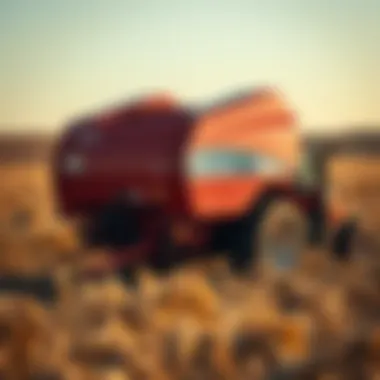
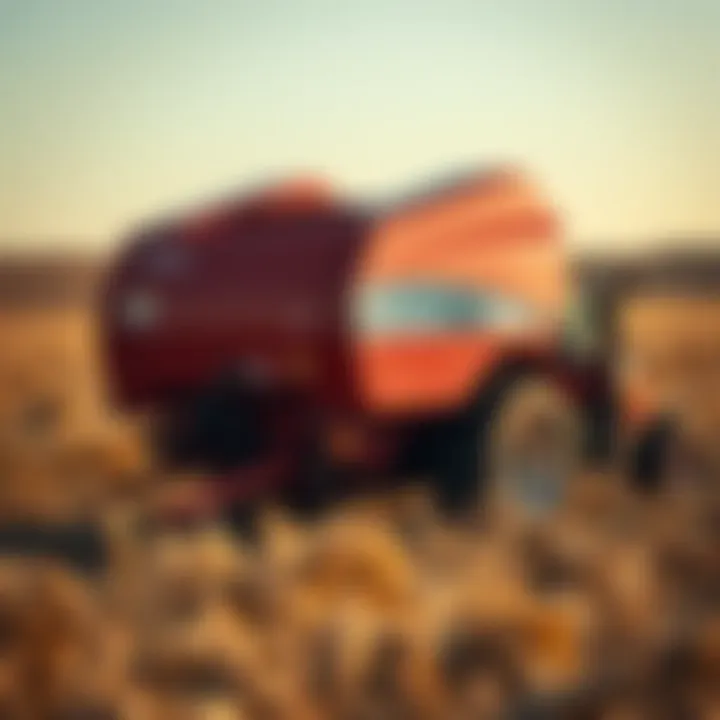
Intro
In the world of agriculture, the efficiency and effectiveness of machinery can significantly impact productivity and yield. One such essential piece of equipment that facilitates the management of hay and straw is the square baler. It’s particularly designed to work seamlessly with small tractors, making it an attractive option for farmers operating on smaller plots of land or those who prioritize compact, manageable equipment.
Square balers have evolved over the years, not just in size but also in technology and application. By understanding their functionalities and advantages, farmers can make informed decisions about their utility in daily operations.
As we dive into this guide, we will navigate through key terms and concepts essential for grasping how square balers fit into modern agricultural practices. Furthermore, we will dissect current trends and innovations in baler technology, explore practical applications, and provide maintenance tips that can prolong the lifespan and enhance the performance of these critical machines.
Understanding Square Balers
Understanding square balers is fundamental for anyone involved in agriculture, particularly those utilizing small tractors. This critical piece of equipment is designed to make hay and straw management more efficient, transforming loose vegetation into compact bales that are easy to handle and store. If you’re aiming for a streamlined operation on your farm, knowing the ins and outs of square balers can be a game changer.
Definition and Functionality
A square baler is a machine that compresses cut crops such as hay or straw into rectangular bales. Unlike round balers, which produce cylindrical shapes, square balers yield bales that are easier to stack, transport, and store. This functionality is crucial for small tractors that might struggle with larger, bulkier machinery. The design results in a neat package, usually measuring 14 x 18 inches or more, making it perfect for small-scale operations.
Operating a square baler involves several steps. First, the machine gathers the material, compresses it into a tight mass, and binds it typically with twine or wire. Once that’s done, the farmer can easily handle the bales either with a fork or by hand, depending on the weight and size. Efficiency is a significant benefit here—by quickly baling crops, farmers can minimize spoilage and maximize productivity during the critical harvesting season.
Historic Context
The journey of square balers dates back to the late 19th century when the need for more efficient farming practices arose. Early versions were often manually operated, requiring significant labor. As technology advanced, the introduction of gas-powered engines in the early 20th century revolutionized the baling process. This adaptation enabled farmers to use mechanized methods to tackle increasingly large fields, ensuring that harvests occurred swiftly and with less human labor.
By the mid-20th century, square balers became more sophisticated, integrating improvements in binding mechanisms and overall design. This evolution paved the way for modern square balers, which are characterized by their ease of use and compatibility with small tractors. These developments echo the broader trend in agriculture—a movement towards automation and efficiency, empowering farmers to focus on other essential tasks while managing their crops. Today, this history highlights the ongoing relevance of balers in contemporary agriculture, cementing their role as indispensable tools for enhancing productivity in the field.
"A machine that not only saves time but also transforms the way we handle our crops is a cornerstone of modern farming."
For more information on the evolution of agricultural equipment, you can explore resources at Wikipedia and Britannica. By understanding the historical significance and current functionalities of square balers, farmers and enthusiasts alike can make informed decisions that impact productivity and efficiency on the farm.
Importance of Balers in Modern Agriculture
Square balers hold a pivotal place in modern agriculture, serving as crucial tools that enhance crop management and optimize productivity. Their ability to efficiently compress harvested forage into manageable bales makes them indispensable on farms, especially those utilizing small tractors. Understanding the variety of roles that balers play sheds light on their importance and benefits.
Role in Crop Management
Balers directly contribute to effective crop management by transforming loose crops, like hay or straw, into bales. This process not only offers a way to store and transport the crop with ease but also minimizes waste significantly. When crops are left in their loose form, several factors such as weather, pests, and decay can take a toll, dwindling the yield.
A baler’s functionality can significantly aid in achieving timely harvests. For instance, when grass or hay is properly baled after cutting, it can save farmers from mushy mishaps caused by rain. The bales are also easier to stack and shield from elements, thus prolonging their usability. Efficient balers come equipped to produce bales that are consistent in size and weight, which simplifies the storage and transport processes.
Moreover, easy management of feed resources helps farmers plan better. They can also employ the bales as bedding for livestock, making it a versatile option that covers several bases. When considering the essential roles of balers, the key takeaway is their ability to streamline crop handling, reduce losses, and effectively utilize resources in a farming set-up.
Effect on Efficiency and Productivity
The efficiency and productivity gains afforded by modern square balers are something farmers cannot overlook. When properly paired with small tractors, square balers can create a significant multiplier effect on the overall productivity of the farm. The mechanical prowess of these machines speeds up the baling process considerably compared to manual handling.
- Time Savings: With a baler, what would take hours can be accomplished in a fraction of the time. This means farmers can spend more time addressing other priorities on the farm.
- Labor Reduction: Using a baler minimizes the need for manual labor, reducing fatigue among workers and increasing the scope for them to perform other tasks efficiently.
- Production Rates: With balers, productivity skyrockets, as they can produce bales rapidly. In many cases, one machine can replace multiple workers, boosting output without compromising quality.
Types of Square Balers Suitable for Small Tractors
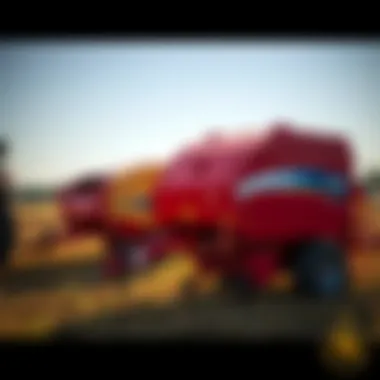
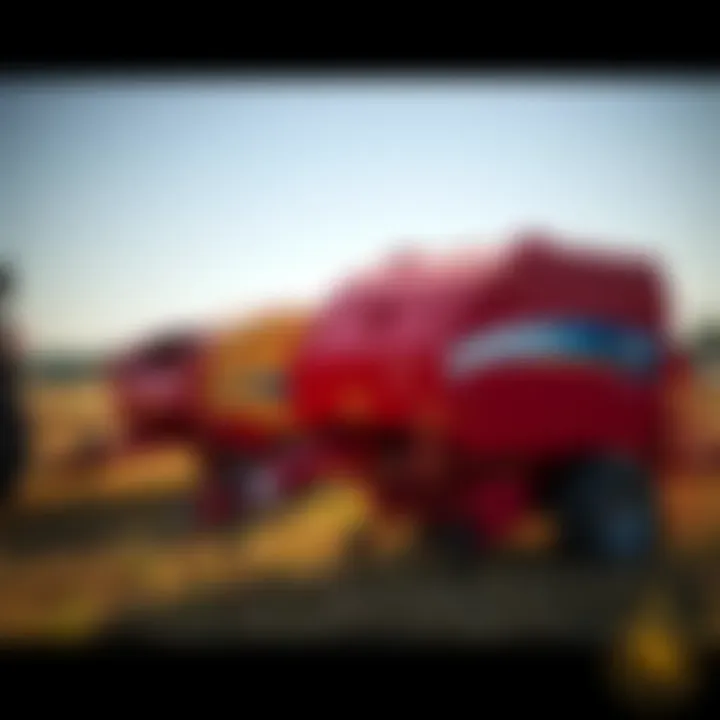
Understanding the landscape of square balers is vital for anyone investing in small tractors for agricultural purposes. The type of baler used can significantly affect operational efficiency and the overall success of a farming venture. Each square baler type offers unique benefits tailored to various operational needs, whether it’s for small-scale hay production or assisting in more extensive agricultural practices. Below, we’ll explore the key distinctions between the types of square balers that are ideal for small tractors, focusing on compact models, mini-square balers, and some specific baler models along with their specifications.
Compact Square Balers
Compact square balers are engineered with smaller tractors in mind, ensuring they can operate efficiently in tight spaces while still producing reliable bales. These balers are relatively lighter and can be easily attached to a variety of small tractor models. Some distinct features include:
- Size: Compact balers are designed to minimize their footprint, making them easier to maneuver around smaller fields.
- Weight Capacity: They can usually handle lighter crops, which is perfect for farmers focusing on hay or straw production without the need for heavy machinery.
- Ease of Use: Most compact balers are user-friendly, allowing farmers to spend less time configuring equipment and more time working the fields.
Benefits of compact square balers include reducing compaction on softer ground, which can be a concern when using larger machinery. This is very important in achieving better crop yields in delicate soil environments.
Mini-Square Balers
Mini-square balers take the idea of compactness further, specifically catering to very small tractors and even some garden tractors. They are a remarkable choice for niche applications, especially in areas where space is constrained.
Several points characterize mini-square balers:
- Bale Size: Generally, mini balers produce smaller bales that are easier to handle, transport, and store – a great advantage for small-scale farms or hobbyists.
- Versatility: They serve multipurpose roles; from small plot farmers to equine facilities, their application is widespread due to their flexibility.
- Cost Efficient: Usually, mini balers come with a lower price tag than more substantial models, making them a wise economic choice for farmers starting out or those focusing on specific smaller jobs.
Mini balers make it feasible to create manageable bales for those not needing large quantities while still delivering reliable performance.
Baler Models and their Specifications
When selecting a square baler, understanding specific models and their specifications is crucial. Various manufacturers create a range of products suited for small tractor compatibility, offering different features based on the farmer's needs. Here are a few prominent baler models:
- John Deere 459E: Known for its reliability and efficient performance, it can produce bales weighing up to 1,200 pounds. It’s equipped with a variable chamber, allowing for different bale densities, which is an appealing factor for farmers looking to customize their operations.
- Bale's mini baler (MB1620): This model is excellent for small estates and produces bales weighing around 50-60 pounds. With its lightweight design, it pairs effortlessly with various small tractors.
- New Holland BB50: This baler is favored for its user-friendly interface and robust performance. It can handle various crops and offers specs that meet the needs of many farmers.
Understanding and comparing specifications, such as the type of tying mechanism, bale size options, and operational rates, enables farmers to make informed decisions and select the baler that aligns with their operational needs.
"Choosing the right baler is like finding the right shoe; it must fit perfectly to enhance performance and comfort in the field."
Factors to Consider When Choosing a Square Baler
When selecting a square baler for small tractors, several factors come into play. These factors are crucial in ensuring the equipment performs efficiently while meeting the specific needs of the farm. A carefully chosen baler can enhance productivity and optimize operational efficiency, while overlooking any element might lead to frustration and unnecessary expenses.
Tractor Compatibility
The first aspect to consider is tractor compatibility. Not all square balers align with every small tractor. Each model has its own specifications, usually dictated by physical size and power output. Assessing the power of the tractor is crucial. For instance, if your tractor is rated at 20 horsepower, you don't want to couple it with a baler requiring 30 horsepower. A mismatch can cause excessive strain on the tractor and could even lead to mechanical failure.
Moreover, the hitch type must be compatible as well. Some balers connect using a pin hitch, while others might use a drawbar. Ensuring compatibility between the tractor and the baler simplifies the operation and promotes a smoother workflow. A good practice is to consult the manufacturer's specifications or the owner’s manual of the tractor.
Bale Size and Weight
The size and weight of the bales produced also play a vital role in your decision. Farmers often have different needs based on transportation and storage capabilities. For example, producing larger bales might be beneficial for those who have ample storage space, but it can create challenges during transportation, especially on narrow roads or where trailers are required.
Understanding the weight is another consideration. Heavier bales can give more yield, but they may not be practical for small tractors to handle. There are usually various bale sizes available, such as mini or standard sizes. Therefore, it’s wise to assess your operational capacity and future needs before making a purchase.
Key Consideration: Evaluate your tractor’s lifting capacity - an underpowered tractor will limit bale handling efficiency.
Mechanical vs. Hydraulic Options
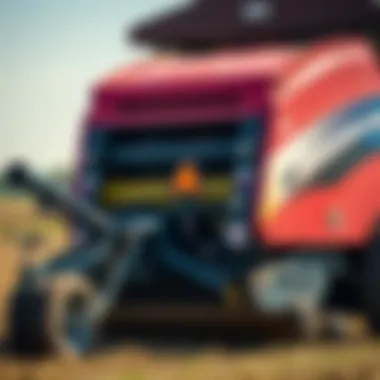
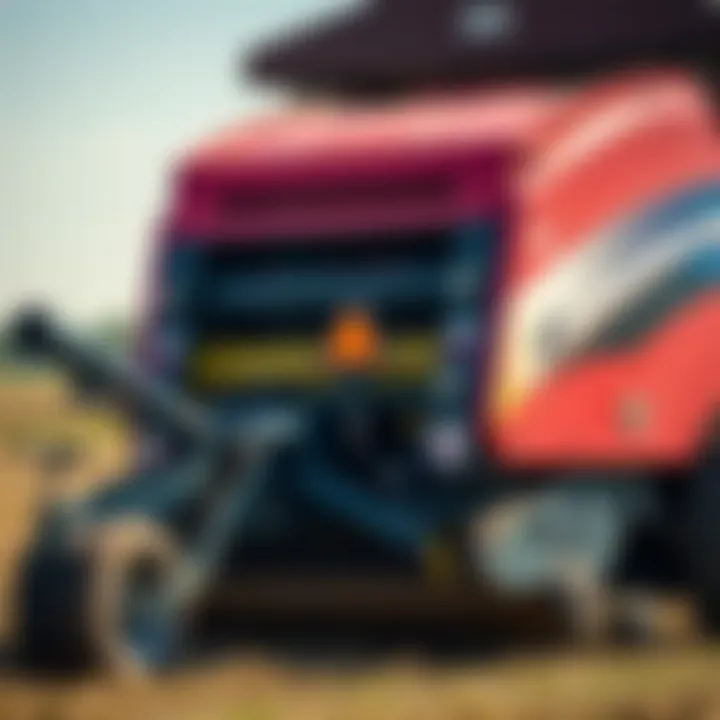
Finally, the choice between mechanical or hydraulic options is significant. Mechanical balers generally rely on gears and levers to accomplish the baling task. They are often simpler, possibly requiring less maintenance. However, they may not offer the same precision or ease of use that some hydraulic systems provide.
On the other hand, hydraulic balers operate through fluid pressure, allowing them to perform tasks with more finesse and flexibility. They tend to be more responsive and can often handle challenging materials or conditions better than mechanical options. Still, they may involve higher maintenance due to complex components.
Weighing the pros and cons for your specific situation is key. Think about what your main requirements are: simplicity or performance.
In summary, choosing the right square baler involves extensive consideration of compatibility with your tractor, the desired bale size and weight, and deciding between mechanical or hydraulic systems. Each factor builds toward creating an efficient, productive, and practical baling operation that meets your agricultural goals.
Operational Considerations
The operational considerations in using square balers for small tractors are paramount for ensuring efficiency, productivity, and longevity of both the equipment and the crops being handled. This section sheds light on the critical elements that can potentially make or break your baling operation. By understanding best practices and recognizing the ideal timing and conditions for baling, farmers can maximize their outputs while minimizing unnecessary complications and costs.
Best Practices for Operation
Implementing best practices is essential for the effective operation of square balers. These practices not only foster efficiency but also enhance the safety of the operation. Here are some key guidelines to consider:
- Pre-Operation Inspection: Always inspect the baler before use. Look for any wear or damage on key components like the belts, pick-up, and knotters. Regular checks can prevent more significant problems down the line.
- Proper Adjustments: Ensure the baler is set correctly for the type of crop and the desired bale size. Adjust the tension on belts for optimal performance and ensure that it accommodates varying conditions.
- Pace and Speed: Avoid rushing the baling process. Maintaining a steady speed allows for consistent bale formation and ensures that everything runs smoothly. Too fast can lead to jams and inconsistent bales.
- Thorough Training: Anyone operating the baler should have proper training on its functions and features. Familiarity with the equipment's controls can significantly improve operation.
"A well-oiled baler runs best," as the saying goes. Taking the time to prepare minimizes problems during peak production times.
Timing and Conditions for Baling
The timing and conditions surrounding your baling efforts can greatly affect the quality of the bales produced. Not all conditions are favorable for baling, and identifying the right time can lead to higher returns on investment. Here are several considerations:
- Moisture Content: The ideal moisture content for hay varies between 15-20%. Bale when it's dry enough to ensure durability but not overly dry, which can lead to excessive leaf loss. Check moisture levels using a moisture meter, if possible.
- Weather Conditions: Avoid baling during wet weather. Ideally, wait until at least 24 hours of dry weather following a rain. Baling in such conditions can result in moldy bales and affect feed quality.
- Crop Maturity: Timing is also reflected in crop maturity. Baling too early might not yield good-quality bales, while waiting too long can lead to shattering losses. Striking a balance here is crucial, particularly for legumes compared to grasses.
- Ground Condition: The condition of the ground can affect operation. Soft, muddy fields can cause ruts and may reduce the speed of your tractor's travel. Opt for drier conditions if possible.
By being mindful of these operational considerations, farmers can ensure they are not only producing quality bales but are also operating in a way that maximizes their equipment's lifespan and reliability. Attention to detail in these aspects will ultimately pave the way for a fruitful and productive farming season.
Economic Aspects of Baling
In any discussion about square balers, particularly when tailored for small tractors, it's crucial to examine the economic dimensions of baling. The financial implications of investing in and maintaining these machines can significantly affect farming operations. Understanding this aspect helps farmers make informed decisions that can lead to enhanced productivity and profitability.
Initial Costs vs. Long-term Benefits
When considering a square baler, one might initially focus on the purchase price. However, the real question lies in the long-term value it brings to the table. The upfront costs often deter potential buyers, leading them to consider cheaper options. Yet, investing in a quality baler usually pays off in spades.
- Quality vs. Price: It's not just about how much money is shelled out initially; the quality of the baler can lead to better efficiency and less downtime.
- Longevity of Equipment: A durable baler, like the New Holland BB125, may be pricier but often lasts longer, saving money on replacements down the road.
- Resale Value: High-quality balers tend to retain their value better than cheaper models. This can be significant if a farmer decides to upgrade later on.
While the initial expenditure feels hefty, consider the long-term benefits:
- Decreased labor costs as a result of higher efficiency.
- Less time spent in the field, allowing for expanded acreage or additional crops within the same timeframe.
In the grand scheme, better yields and lower operational costs make the investment worth it. Adopting this long-sighted viewpoint should give farmers a clearer picture of their potential returns on investment.
Maintenance Costs and Budgeting
Just like any other equipment, square balers require regular upkeep to stay in optimal working condition. The importance of budgeting for maintenance cannot be overstated. Inadequate maintenance often leads to breakdowns, which not only disrupt operations but can create additional financial burdens.
Here are some key components to think about:
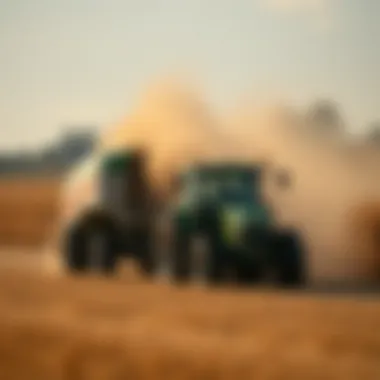
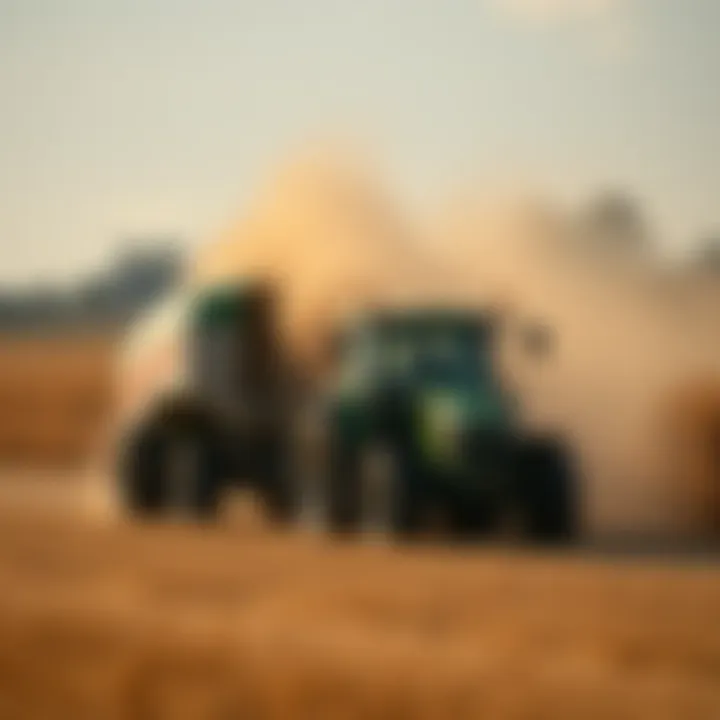
- Routine Maintenance: Regular checks on the baler's core elements can prevent more serious issues.
- Parts Replacement: Understanding which parts wear out quickly and budgeting for their replacement is essential. For instance, knives and belts might need periodic replacements depending on usage.
- Unexpected Repairs: It's wise to set aside a fund for unexpected issues that may arise. A sudden breakdown might require immediate attention and substantial expenditure.
Prioritizing these costs within a budget can streamline operations and reduce the risk of financial surprises. And don't forget:
“An ounce of prevention is worth a pound of cure.”
By planning for expenses associated with maintaining a square baler, farmers can foster a sustainable and productive farming operation. This proactive financial approach enables farmers to maximize the benefits of their investments, ensuring that square balers serve their purpose effectively over the long haul.
In summary, understanding the economic aspects of baling reveals that despite the initial costs, the long-term benefits and proper budgeting for maintenance can significantly enhance farm productivity and sustainability.
Maintenance and Care for Square Balers
Maintaining square balers is not just a chore; it's an investment in the efficiency and longevity of your equipment. Just like any other machinery on a farm, square balers need regular care to function properly. Overlooking maintenance can lead to breakdowns, which often happen at the most inconvenient times. So, paying attention to the day-to-day upkeep can spare you both time and money in the long run.
Routine checks can significantly reduce the risk of unexpected malfunctions and keep your baler operating at peak performance. When you ensure that every component is in tip-top shape, you're also preserving the quality of the bales produced.
Routine Maintenance Practices
The crux of effective maintenance hinges on adopting a routine that fits your operational pace. Here’s a breakdown of essential practices:
- Daily Checks: Before embarking on baling tasks, inspect the baler for any visible wear and tear. Look for signs of rust or cracks, especially on key components like the chamber and augers.
- Lubrication: Keeping moving parts lubricated reduces friction and wear. Oil the chains and check the bearings regularly—especially during harvest season when the baler is working overtime.
- Tensioning Belts and Cables: Just like a finely tuned piano, a baler requires the correct tension in its belts and cables. Regularly check their tension to minimize slippage or excessive wear.
- Cleaning: After each use, remove debris and hay buildup. Blockages can lead to overheating or even fires. A clean baler is a happy baler.
- Periodic Inspection of Mechanical Components: Schedule detailed inspections every few weeks or after significant work. This could involve looking at hydraulic systems, checking for leaks, and ensuring that parts are not excessively worn.
The aim of routine maintenance is not just to prevent breakdowns but also to enhance the overall productivity of your baler.
Troubleshooting Common Issues
Even with diligent maintenance, problems can arise that may require immediate attention. Here are some common issues you might face with square balers and how to troubleshoot them:
- Bale Jamming: If bales are consistently jamming, it might be due to improper feeding. Make sure the material is adequately conditioned and not too dense. Sometimes, adjusting the speed of your tractor can help.
- Uneven Bale Density: This is often tied to inconsistent moisture levels in the crop or issues with the baler’s compaction system. Check the moisture content before baling and ensure that the baler’s settings are appropriate for the material being processed.
- Hydraulic Problems: If the baler’s hydraulic system shows erratic behavior, inspect the hoses for leaks and connections. Air in the hydraulic lines can also cause issues, so bleed the system if necessary.
- Mechanical Failures: If you hear unusual noises or notice vibrations that weren’t there before, this could signal a malfunction in a moving part. Turn off the baler immediately and conduct a thorough inspection. Replacing worn out parts as soon as possible can save you from bigger headaches later.
"Regular maintenance is the key to keeping your square baler performing well—not just to avoid downtime, but to ensure you’re getting the best quality bales possible."
In wrapping this topic up, understanding maintenance and care for square balers equips you with essential knowledge that can enhance your agricultural endeavors. A well-maintained baler not only works better but also contributes to the overall efficiency and productivity of your farming operation. Investing time in maintenance means you’re investing in the longevity and performance of your machinery.
Culmination and Future Outlook
As the world of agriculture continues to evolve, square balers remain a linchpin in maintaining efficiency and productivity, particularly for small tractor users. Understanding the role of these machines is vital, not only for current practices but also for forecasting future trends that might shape modern farming. The continual advancement in baler technologies speaks to the inventive spirit of the agricultural community, focusing on maximizing output while minimizing labor and resource costs.
Emerging Technologies in Baling
New developments are bubbling up in baling technology. For instance, precision agriculture is beginning to infiltrate the baling process. By integrating GPS and IoT devices, farmers can track the bailing process in real-time, ensuring that all parameters are optimized for the highest quality yield. Machine learning algorithms can analyze various data points such as soil moisture levels and weather patterns, leading to more timely and efficient baling practices.
Some manufacturers are also making strides in improving material handling. Advanced hydraulics and more robust build quality now allow balers to handle a wider range of crop types. For example, yesterday’s balers were made primarily for hay, but today’s innovations are landing new functionalities that make it easier to work with wet materials, like silage. This is a game changer for farmers needing flexibility in their operations.
Furthermore, with a growing awareness of sustainability, balers are becoming more eco-friendly. Look for models that utilize renewable energy sources, reducing the carbon footprint associated with baling operations. Energy-efficient designs are set to become the norm rather than the exception in the future.
Final Thoughts on the Role of Balers in Agriculture
Square balers are not just machines; they are vital components of a successful agricultural strategy. They contribute significantly to the efficiency of fodder collection and aid greatly in preserving the quality of feed. For farmers, the ability to produce bales that are uniform in size and density is crucial for storage and transport.
As the landscape of farming continues to shift, square balers will undoubtedly adapt to meet changing needs. These machines provide invaluable services, linking the crop management lifecycle from harvest to feed storage.
In summary, small tractor users must remain attuned to both the immediate benefits of their balers and the future innovations on the horizon. Embracing new technologies and staying informed will empower farmers to enhance their operations, maximize yield, and adapt to both challenges and opportunities in agriculture.
"The best preparation for tomorrow is doing your best today." - H. Jackson Brown, Jr. Discovering the right baler today can pave the way for a sustainable and productive tomorrow.







